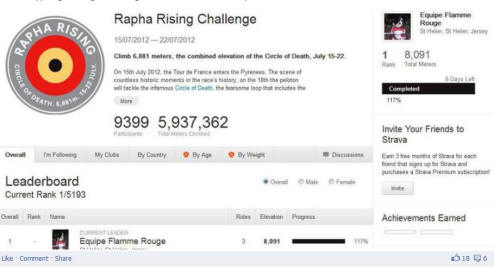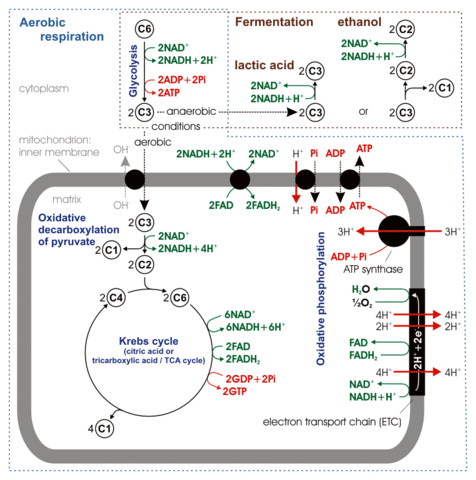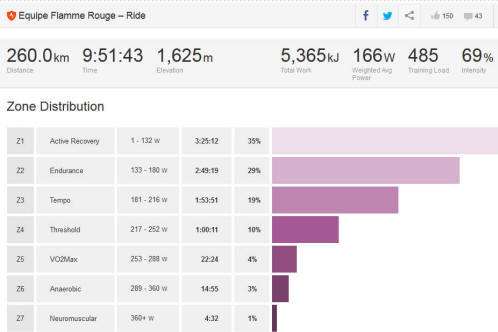Zonelander ~ Base Station Oxygen

flamme rouge
Road Captain Mick Heald
Recovering after a (scheduled, mid-season!) intense session
The problem with athletes, cyclists in particular, is that they often feel that unless they get home, or finish a session totally smashed, it isn't really training. Well sometimes that's true, but not always.
I often say, if you haven't tasted a little bit of sick in your mouth then you've not gone hard enough. But not for every single session! Especially as winter approaches.
As I type this, it's September; we're closer to the start of last season than we are to the start of next season. I'd suggest there's no need to be screaming around at warp factor sprint, for most of your training rides!
Here's why I believe you should be riding as though you were taking your bike for walk...

smelling the flowers with your mates...
me, Road Captain Jason Stratford
and his "wasp
catcher" helmet
Season Backout
If you've been competing all summer, chances are you've been
training for the previous five months before that. That's a
long, long, time to be "on it". And most "non-professionals"
do just that. They try to stay on it for the whole of their
competitive year.
We've had Base, Pre-Comp, Early-Comp and Peak; now it's time to Transition and backout out of our successful year.
Do not fear letting your summer fitness erode as winter appears. Gaining fitness is like tackling a hill; it's much better if you can take a run up to it.
Letting your summer fitness drop, and your autumn freshness increase, is the physiological equivalent of having a fast descent before you hit the bottom of a big climb.
To get fitter, faster and stronger for next season, you need to back out from this one. You need to wean yourself off the FTP & VO2max intervals you've probably been banging out for a late season peak.
Controlled de-training is the way forward. For those unsure how to do this, just ride your "normal" Grey Week adaptation intervals, but at Tempo Pace. Ease out gently, then make time for your end of season break.
Some older riders (the Super Vets) with a huge thirty year base behind them, may not wish to stop completely, which is fine. I ride all year round, but really control my intensity and volume. Anyone that knows me, will tell you I rarely "over-extend" myself!
New riders, or those yet to spot the correlation, often ride full-gas all through the season and become physically and mentally drained as the autumn approaches. They then train harder to get fit for the club runs, only to crash and burn in the early Spring.
To survive, these riders should, if not must, take a physical and mental fortnight break from their cycling. The world will not end, and you will not die, by taking a post-season, two week rest.
Control your destiny. Make sure that break is taken by you, not for you, when your body physiologically implodes. Because if you don't, it will.
Listen to your body and stay ahead of the curve; always feeling tired is NOT NORMAL!
The physiological continuum ~ The dreaded Zones of Suffering
Zone Two ~ Where the magic happens!
Once you've come down from your fitness pedestal, you can start
rebuilding a new and higher one. This is where the often
neglected Zone Two work comes in.
You can almost sense the question, "If the magic happens in Zone Two, then surely there must be more magic in Zone Three?" Sadly not.
We've discussed this elsewhere on the site, but most winter club runs and group rides around the world, are too fast.
Many sit slap bang in the middle of Zone Three, the Dead Zone, The Zone of Diminishing Returns.
Every weekend ride becomes an impromptu Hammer Time; same route, same speed, same result ~ average, chronic mediocrity. Training becomes Sisyphean in it's outlook and quality.
Bragging rights revolve around average speeds, people dropped and getting home with three-quarters of a bidon left because it was "too fast to take a drink". Awesome...

Be an outlier ~ it's so much more fun...
To be in a minority of one, doesn't make you mad ~ George Orwell -
1984
Escape the Cult of Average
There are now so many films,
internet clips, and power files, about pro teams out
there, it's not hard to take the time to check out a few.
One thing you'll notice is how easy the pros endurance rides are. They may be riding 10 kph faster than we do, but they are most definitely, in their zone two. Riding side by side, chatting, without a care in the world. Getting in the miles. Stressed, they are not.
Cycling is a sport powered by oxygen. Whether you like
it or not, it's all about oxygen uptake; not the size of your
muscles, not the cost of your bike, not the size of your peak watts,
not your max heart rate, not how many Strava KOM's you have. It's oxygen uptake.
You'll see above what building an excellent oxygen delivery system can do for an average rider. Which is all I am.
I aimed to do the above 6,881 metre Strava climbing challenge in one hit. I'd previously climbed over 8000 metres in a day, so I knew it was doable. But our highest climb in Jersey is 100 metres, so it proved a tadge time consuming and I just run out of daylight and had to complete it the next morning.
This was all zone two climbing; slow, steady, oxygen delivered, fat burner central. For a few days, I was a Strava World Champion! How sad...
You can only do, or prepare well, for these type of rides by riding extended periods of time in zone two. Here's why.
Oxygen Uptake
There are many factors that surround oxygen uptake, and far too many to
go in to detail here. We've explained it in
other areas of the site, but for now
here's a quick recap...
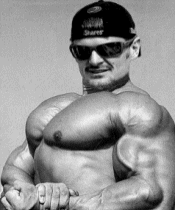 You
breath in and air fills your lungs, from which, the oxygen is
stripped out. From inside the lungs the oxygen is
transferred (by magic minions) to your blood.
You
breath in and air fills your lungs, from which, the oxygen is
stripped out. From inside the lungs the oxygen is
transferred (by magic minions) to your blood.
The oxygen-saturated blood then wings its way to the muscles, the speed and urgency of which, is regulated by your heart rate.
Which is always reacting to demand, not pre-empting it. Heart rate always lags effort.
The muscles grab the oxygen, deliver it to the cellular "coal face" and mix it with other stuff to create a chemical explosion to propel your bike forward.
How fantastically ingenious is that? So what's the problem?
Well one of the main ones is, there's no use having a six litre lung capacity if you only have four litre legs!
And once more, this has nothing to do with muscle size. If it was, the "naughty boys" would have taken steroids not EPO or blood transfusions.
So forget weight training, forget bulking up, forget 100 kilo squats. Sort your oxygen delivery systems out by making them more efficient, and surprisingly quickly, you'll become very much more effective.
Theatre of the Absurd
As you may have already worked out, my rant for the day is that oxygen uptake, and cycling
economy and efficiency, are developed in
zone two.
Here, to prove it's not all made up stuff, is how the scientists view it...
Depiction of Cellular Respiration by Darekk2
We've covered energy production in our Electro-Chemical Warfare factsheet. To be a faster rider you don't need to understand any of the stuff in the diagram above.
But if you grasp the fundamentals explained below you'll gain a better understanding of why riding a little slower in the autumn will help you go much faster in the summer.
The main aim of this site is to de-mystify the mysterious. I try to take the science-geeky stuff and relate it to our everyday riding, hopefully without making it banal, patronising or condescending. So a quick overview...
Our primary endurance propulsion system, is the aerobic energy system. Aerobic means "with oxygen" Sports scientists call this "cellular respiration" or mitochondrial respiration".
As you can see from the continuum diagram below, ALL energy production is a combination of the, with oxygen, aerobic and without oxygen, anaerobic systems.
Energy is produced from a mix of the two systems, the proportion of which is represented by the area in each column above or below the diagonal speed line, moving across the chart from bottom left to top right.
As in a car, we consume fuel to provide energy. Unlike a car, we have two main fuel systems, fat and carbohydrates (there are more but we'll deal with just the major ones here).
The predominant aerobic energy supplier is fat.
Carbs, processed as glycogen, are the predominant anaerobic energy supplier.
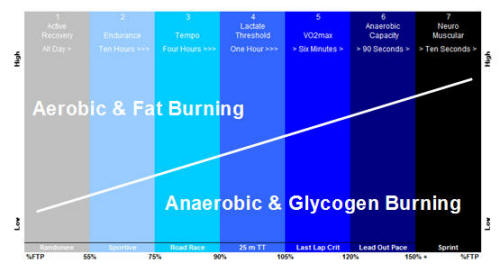
These two fuels also sit either side of the line; above the line is fat, below the line is carbs. Again, all energy production is combination of these two macro nutrients. The further right of the chart you go the more the mix moves to predominantly anaerobic energy and carb usage.
The double whammy of zone two riding is that you not only increase the efficiency of your oxygen delivery systems, you "train" the body to use fat as a fuel. How good is that?
Training in zone two moves the "crossover tipping point" further up the speed band and effectively, shifts the diagonal line down and/or to the right. Which is a very good thing!
The higher the fat to carb fuelling ratio, at any given speed. means there will be more glycogen available when it really kicks off on the last climb of a race, or the last lap of a crit.
It should also be borne in mind that high lactate is only produced when we burn glycogen. You don't produce high lactate when riding aerobically and burning fat.
In fact zone two riding also allows your body to burn lactate as a fuel. Especially important if you are an IronMan athlete or an ultra endurance competitor. Does it get any better?
Here's one I prepared earlier...
This is a recent ride (September 2014) I did to prove that you can ride a very long way, on very little food (but a lot of drink) if you ride in your fat burning zone.
I'm 70 kilos, 12% body fat; that's 8.4 kilos of fat! Fat has the potential of supplying 37 kilojoules (9 Calories) of energy per gram. Theoretically, my body fat can supply 3,108,000 kilojoules of energy!
As you can see, I burned just 5,365 kj in the ten hour, 260 km ride above. If nothing else, this ably demonstrates the huge gains you can make, if you can ride a little slower to activate and make use of these huge energy reserves that you have to carry around regardless of using them or not.
Oxygen Delivery
Our
own little "minions of choice", referred to above, are mitochondria.
These little lovelies are the oxygen carrying sacs that "drop off" their explosion enabling cargo at the muscle coal face.
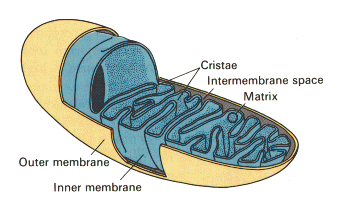 They also mop up stuff we don't need and take it back to
the
lungs to flush out and get rid of when we exhale.
They also mop up stuff we don't need and take it back to
the
lungs to flush out and get rid of when we exhale.
When they get to the muscles they travel down the available capillaries. Which is where our first bottleneck occurs.
This is where I point out to you, that in a fantastic feat of human engineering, our muscle capillaries are exactly one mitochondria wide. Information that is crucial to your understanding of oxygen uptake.
Geek Alert! ~ we're going in to concept mode here; these aren't real numbers, they're just to prove my point!
There's no use having a thousand, bursting at the seams, truck sized, oxygen carrying mitochondria, screaming from your huge "oxygen warehouse" lungs, down a six-lane freeway of a blood delivery system, to end up parked at the end of your muscle, queuing to get down five hundred busy, blocked, back road sized, muscle capillaries.
Hence my six litre lungs, four litre legs reference.
If you can develop a thousand leg muscle capillaries to take all of the mitochondria arriving in one go, then hey presto, you're now a fitter, faster, stronger rider. It really is as simple as that.
Increasing muscle capillarization (their density) allows a higher volume of mitochondria to arrive at the coal face in one hit. This subsequent increase in oxygen delivery creates a much bigger bang for every single muscle contraction.
The increased pathways also allow a quicker clearing of metabolites, enzymes and "spent fuel" to improve recovery times and allow another, bigger, "bang" to take place sooner.
Couple this with the parallel development of slow-twitch muscle fibres, increased cardiac output (which results in decreased heart rate), an energising of fat metabolism energy pathways, and it's difficult to see how zone two can be beaten for performance gains.
This would also be a good time to point out, that it's the Type One, slow-twitch muscle fibres that hold the enigmatic MCT-1 transporters. A new creature for you, whose main responsibility is shuttling lactate to the mitochondria for removal from the muscles.
So the fact that we have a system that gives us; more endurance powering muscle fibres, more lactate flushing transporters, more oxygen carrying mitochondria and more explosive muscle capillary density, by riding slower, may give a slight hint as to why I'm forever screaming "EASY!" on our rides that have a "no-shout rule."
We really should get some team radios!
If you've absorbed most of the above, it's probably now a little easier to understand why zone two is the most beneficial, yet most underused, training tool for the vast majority of "normal" cyclists.
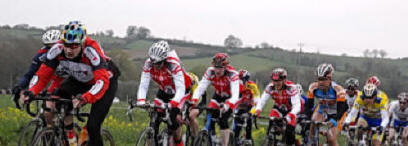
In the (wrong) Zone
working hard in the early season races of the
Loire Valley
Two Zone Good ~ Three Zone Bad?
Most of the gains listed above can also be attributed to zone
three work, and some of it in greater depth. But the physiological cost of riding in zone three is huge compared
to that of zone two.
Time-poor riders, in an attempt to maximise their training time, will do two hours, zone three tempo riding, rather than three hours, zone two endurance riding.
At the end of their ride, the perception of their short ride training gains may seem similar, if not better to that of the longer, less intense ride.
But the physiological cost of their effort is muscle trauma, lactate production, glycogen usage, cumulative fatigue, and not enough stimulation to create gains in other areas.
As we said above, it's the Zone of Diminishing Returns.
Yes you've fired up the exercise endorphins and feel great, but at what cost? This is the riding that coined my saying the "slow rides are too fast and the fast rides are too slow". Yes it's where the summer racing may take place, but that doesn't mean it's good for winter training.
Two hours in zone two is a better training investment than two hours in zone three. It might not feel like it at first, but when it comes the time to do your FTP and VO2max work, you'll notice it big time.
Finding Zone Two
 You don't need a power meter, heart monitor or any fancy gadgets to
pinpoint zone two. You just need to pay attention!
You don't need a power meter, heart monitor or any fancy gadgets to
pinpoint zone two. You just need to pay attention!
If you're in zone two, you can talk with your mates. Effort sensation is "comfortable", you just need to remember to eat and drink on long rides, as it's easy to forget to do so when you ride at this "unchallenging" level.
It's as simple as that. Personally I like to ride around 25-30 kph.
I try to keep it around 25 kph, everyone else I ride with tries to nudge it up to 30 kph. Oh how we laugh!
If you have a heart monitor, then you're looking at 60-65% max heart rate. If you have a power meter, you're looking at below 75% of your FTP. The only reason you should be using these gadgets is to stop you "drifting" in to zone three.
There will be cardiac drift over the course of your ride, but don't take these things too seriously. You will know when you've moved out of zone two. Make a conscious decision not to.
As mentioned on the Continuum Factsheet, there is no flip-flop from one zone to the next. You're not in zone two at 64% heart rate and in zone three at 66%; it's a sliding scale of physiological reactions and adaptations. The closer you can stay to the lower-to-mid section of each zone, the better returns you will get.
Here's the full list of zones and their physiological descriptions...
As a final point. During these rides, just drink water. You don't need fancy isotonic, calorie-laden energy drinks to fuel a zone two ride. Or gels or bars! Just drink water and maybe some fruit.
If you've eaten right the night before and for breakfast, that should be enough to keep you powered up and encourage the body to use fat rather than carbs as fuel. If you eat carbs, you'll burn carbs.
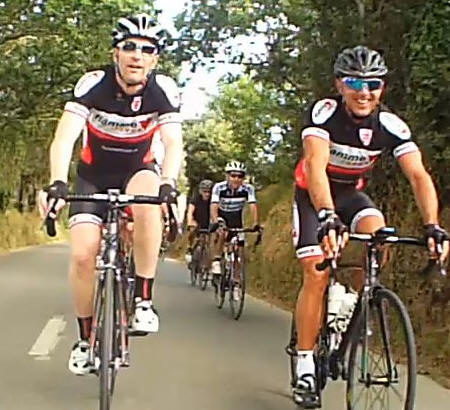
This is what Zone Two is all about
Craig Grant & Richard Mayne ~ comparing
tans and having fun!
The Message
Embrace the ambiguity of being apart from the herd. Allow yourself to be part of the
experiment and take the road less travelled. Do less to gain
more. It really is that simple.
You don't need a power meter, you don't need a sports test, you don't need a heart monitor.
Just ride, and chat, with your mates. If you can't chat, then you're going too fast. Back off and get home thinking, I should have done more.
If you don't get home thinking that; you've done too much.
Enjoy this moment. Because when the training starts and we go, we go. A flamme rouge rider is either going embarrassingly slow or leg screamingly fast. The middle bit will look after itself.
Remember, medals are only awarded in the summer, they are "won" in the winter. Don't compromise, or get upset about, next season's results by the work you failed to do this winter.
Not all work has to be intense. Icing on a cake is nice, but you wouldn't want a cake made of just icing!
See you next month for a further installment of platitudes, pithy statements and more clichés than you can shake a stick at!
Eat, drink and be merry, for tomorrow we ride... Gently!


